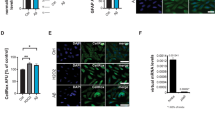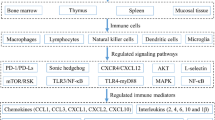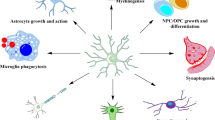Abstract
Objectives and design
Microglia play an important role in immune and inflammatory responses in the central nervous system. Astragalus polysaccharide (APS) has been reported as an immune stimulant for various inflammation-associated diseases in vivo. The present study investigated the effects of APS on lipopolysaccharide-stimulated inflammatory responses in microglial cells.
Materials and methods
Cultured BV2 microglial cells were pre-treated with APS (0–200 μg/ml) prior to lipopolysaccharide (50 ng/ml) stimulation. The production of proinflammatory mediators including inducible nitric oxide synthase (iNOS)/nitric oxide (NO), cyclooxygenase-2 (COX-2)/prostaglandin E (PGE2), tumor necrosis factor-α (TNF-α) and interleukin-1β (IL-1β) were evaluated.
Results
APS dose-dependently reduced lipopolysaccharide stimulated nitric oxide and PGE2 production, as well as iNOS and cyclooxygenase-2 gene expression. It also attenuated proinflammatory cytokines IL-1β and TNF-α generation. In addition, APS inhibited nuclear factor-κB translocation by blockade of IκB degradation and suppressed protein kinase B phosphorylation in lipopolysaccharide-stimulated cells.
Conclusions
The inhibitory effects of APS on lipopolysaccharide-stimulated inflammatory mediator production in microglia are associated with suppression of nuclear factor-κB and protein kinase B signaling pathways. APS may offer therapeutic potential for treating inflammatory and neurodegenerative diseases accompanied with microglial activation.






Similar content being viewed by others
References
Kettenmann H, Hanisch UK, Noda M, Verkhratsky A. Physiology of microglia. Physiol Rev. 2011;91:461–553.
Cunningham C. Microglia and neurodegeneration: the role of systemic inflammation. Glia. 2013;61:71–90.
Graeber MB, Li W, Rodriguez ML. Role of microglia in CNS inflammation. FEBS Lett. 2011;585:3798–805.
Zhang Y, Chen WA. Biochanin A inhibits lipopolysaccharide-induced inflammatory cytokines and mediators production in BV2 microglia. Neurochem Res. 2015;40:165–71.
Lee HJ, Kim KW. Anti-inflammatory effects of arbutin in lipopolysaccharide-stimulated BV2 microglial cells. Inflamm Res. 2012;61:817–25.
Depboylu C, Stricker S, Ghobril JP, Oertel WH, Priller J, Hoglinger GU. Brain-resident microglia predominate over infiltrating myeloid cells in activation, phagocytosis and interaction with T-lymphocytes in the MPTP mouse model of Parkinson disease. Exp Neurol. 2012;238:183–91.
Lee M, McGeer E, McGeer PL. Activated human microglia stimulate neuroblastoma cells to upregulate production of beta amyloid protein and tau: implications for Alzheimer’s disease pathogenesis. Neurobiol Aging. 2015;36:42–52.
Sanagi T, Nakamura Y, Suzuki E, Uchino S, Aoki M, Warita H, et al. Involvement of activated microglia in increased vulnerability of motoneurons after facial nerve avulsion in presymptomatic amyotrophic lateral sclerosis model rats. Glia. 2012;60:782–93.
Fu J, Wang Z, Huang L, Zheng S, Wang D, Chen S, et al. Review of the botanical characteristics, phytochemistry, and pharmacology of Astragalus membranaceus (Huangqi). Phytother Res. 2014;28:1275–83.
Ma XQ, Shi Q, Duan JA, Dong TT, Tsim KW. Chemical analysis of Radix astragali (Huangqi) in China: a comparison with its adulterants and seasonal variations. J Agric Food Chem. 2002;50:4861–6.
Yuan W, Wang J, Wu T. Chinese herbal medicine Huangqi type formulations for nephrotic syndrome. Cochrane Database Syst Rev 2008:CD006335.
Sang Z, Zhou L, Fan X, McCrimmon RJ. Radix astragali (Huangqi) as a treatment for defective hypoglycemia counter regulation in diabetes. Am J Chin Med. 2010;38:1027–38.
Liu C, Wang G, Chen G, Mu Y, Zhang L, Hu X, et al. Huangqi decoction inhibits apoptosis and fibrosis, but promotes Kupffer cell activation in dimethylnitrosamine-induced rat liver fibrosis. BMC Complement Altern Med. 2012;12:51.
Fu S, Zhang J, Menniti-Ippolito F, Gao X, Galeotti F, Massari M, et al. Huangqi injection (a traditional Chinese patent medicine) for chronic heart failure: a systematic review. PLoS One. 2011;6:e19604.
Cheng XD, Hou CH, Zhang XJ, Xie HY, Zhou WY, Yang L, et al. Effects of Huangqi (Hex) on inducing cell differentiation and cell death in K562 and HEL cells. Acta Biochim Biophys Sin (Shanghai). 2004;36:211–7.
Cao J, Chen Z, Zhu Y, Li Y, Guo C, Gao K, et al. Huangqi–Honghua combination and its main components ameliorate cerebral infarction with Qi deficiency and blood stasis syndrome by antioxidant action in rats. J Ethnopharmacol. 2014;155:1053–60.
Wang XH, Jia HL, Deng L, Huang WM. Astragalus polysaccharides mediated preventive effects on bronchopulmonary dysplasia in rats. Pediatr Res. 2014;76:347–54.
Orre M, Kamphuis W, Dooves S, Kooijman L, Chan ET, Kirk CJ, et al. Reactive glia show increased immunoproteasome activity in Alzheimer’s disease. Brain. 2013;136:1415–31.
Luo T, Wu J, Kabadi SV, Sabirzhanov B, Guanciale K, Hanscom M, et al. Propofol limits microglial activation after experimental brain trauma through inhibition of nicotinamide adenine dinucleotide phosphate oxidase. Anesthesiology. 2013;119:1370–88.
Harms AS, Cao S, Rowse AL, Thome AD, Li X, Mangieri LR, et al. MHCII is required for alpha-synuclein-induced activation of microglia, CD4 T cell proliferation, and dopaminergic neurodegeneration. J Neurosci. 2013;33:9592–600.
Liu M, Qin J, Hao Y, Liu M, Luo J, Luo T, et al. Astragalus polysaccharide suppresses skeletal muscle myostatin expression in diabetes: involvement of ROS-ERK and NF-kappa B pathways. Oxid Med Cell Longev. 2013;2013:782497.
Zhang CL, Ren HJ, Liu MM, Li XG, de Sun L, Li N, et al. Modulation of intestinal epithelial cell proliferation, migration, and differentiation in vitro by Astragalus polysaccharides. PLoS One. 2014;9:e106674.
Li RJ, Qiu SD, Chen HX, Tian H, Wang HX. The immunotherapeutic effects of Astragalus polysaccharide in type 1 diabetic mice. Biol Pharm Bull. 2007;30:470–6.
Jiang JB, Qiu JD, Yang LH, He JP, Smith GW, Li HQ. Therapeutic effects of astragalus polysaccharides on inflammation and synovial apoptosis in rats with adjuvant-induced arthritis. Int J Rheum Dis. 2010;13:396–405.
Lu J, Chen X, Zhang Y, Xu J, Zhang L, Li Z, et al. Astragalus polysaccharide induces anti-inflammatory effects dependent on AMPK activity in palmitate-treated RAW264.7 cells. Int J Mol Med. 2013;31:1463–70.
Liu QY, Yao YM, Zhang SW, Sheng ZY. Astragalus polysaccharides regulate T cell-mediated immunity via CD11c (high) CD45RB (low) DCs in vitro. J Ethnopharmacol. 2011;136:457–64.
Frank-Cannon TC, Alto LT, McAlpine FE, Tansey MG. Does neuroinflammation fan the flame in neurodegenerative diseases? Mol Neurodegener. 2009;4:47.
Bourke E, Kennedy EJ, Moynagh PN. Loss of I kappa B-beta is associated with prolonged NF-kappa B activity in human glial cells. J Biol Chem. 2000;275:39996–40002.
Yao ZA, Xu L, Wu HG. Immunomodulatory function of kappa-carrageenan oligosaccharides acting on LPS-activated microglial cells. Neurochem Res. 2014;39:333–43.
Vo TS, Ngo DH, Ta QV, Wijesekara I, Kong CS, Kim SK. Protective effect of chitin oligosaccharides against lipopolysaccharide-induced inflammatory response in BV-2 microglia. Cell Immunol. 2012;277:14–21.
Dilshara MG, Lee KT, Kim HJ, Lee HJ, Choi YH, Lee CM, et al. Anti-inflammatory mechanism of alpha-viniferin regulates lipopolysaccharide-induced release of proinflammatory mediators in BV2 microglial cells. Cell Immunol. 2014;290:21–9.
Kaushik DK, Thounaojam MC, Mitra A, Basu A. Vespa tropica venom suppresses lipopolysaccharide-mediated secretion of pro-inflammatory cyto-chemokines by abrogating nuclear factor-kappa B activation in microglia. Inflamm Res. 2014;63:657–65.
Zhang YW, Wu CY, Cheng JT. Merit of Astragalus polysaccharide in the improvement of early diabetic nephropathy with an effect on mRNA expressions of NF-kappa B and I kappa B in renal cortex of streptozotoxin-induced diabetic rats. J Ethnopharmacol. 2007;114:387–92.
Kim EK, Choi EJ. Pathological roles of MAPK signaling pathways in human diseases. Biochim Biophys Acta. 2010;1802:396–405.
Manukyan MC, Weil BR, Wang Y, Abarbanell AM, Herrmann JL, Poynter JA, et al. The phosphoinositide-3 kinase survival signaling mechanism in sepsis. Shock. 2010;34:442–9.
Liu M, Wu K, Mao X, Wu Y, Ouyang J. Astragalus polysaccharide improves insulin sensitivity in KKAy mice: regulation of PKB/GLUT4 signaling in skeletal muscle. J Ethnopharmacol. 2010;127:32–7.
Ye MN, Chen HF, Zhou RJ, Liao MJ. Effects of Astragalus polysaccharide on proliferation and Akt phosphorylation of the basal-like breast cancer cell line. Zhong Xi Yi Jie He Xue Bao. 2011;9:1339–46.
Acknowledgments
This study was supported by Nature Science Foundation of China, Grant number 81102863, 81271205; and Nature Science Foundation of Hubei Province, Grant number 2012FFB04437, 2013CFB252.
Author information
Authors and Affiliations
Corresponding authors
Additional information
Responsible Editor: John Di Battista.
J. Qin is a co-first author.
Rights and permissions
About this article
Cite this article
Luo, T., Qin, J., Liu, M. et al. Astragalus polysaccharide attenuates lipopolysaccharide-induced inflammatory responses in microglial cells: regulation of protein kinase B and nuclear factor-κB signaling. Inflamm. Res. 64, 205–212 (2015). https://doi.org/10.1007/s00011-015-0798-9
Received:
Revised:
Accepted:
Published:
Issue Date:
DOI: https://doi.org/10.1007/s00011-015-0798-9




